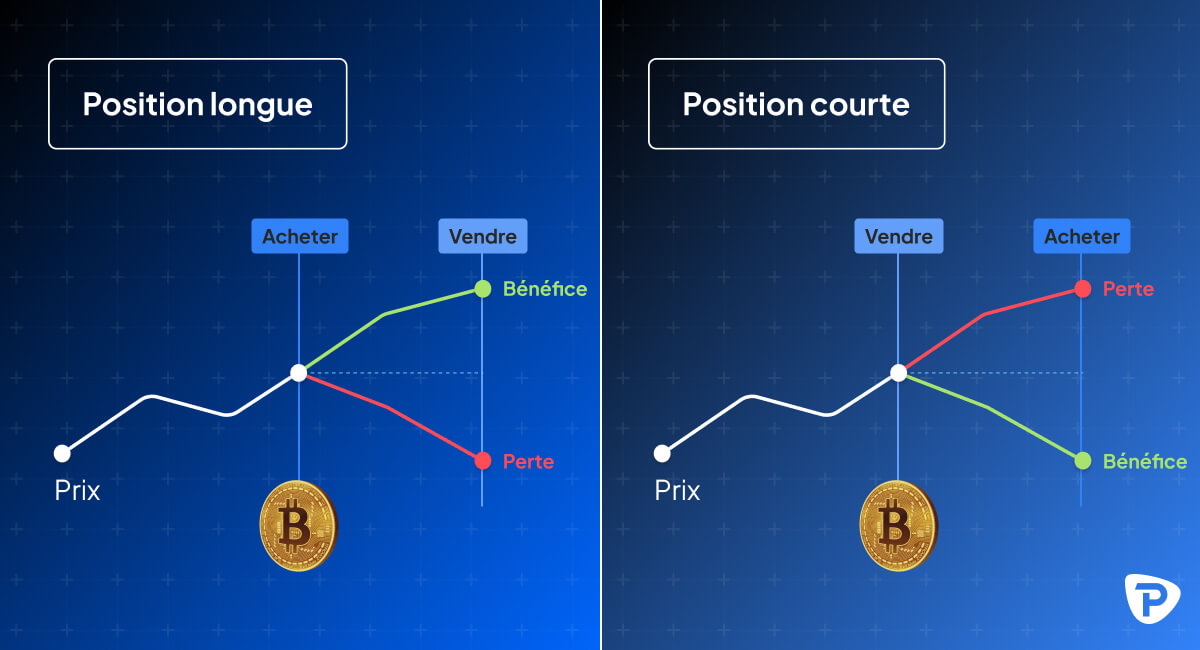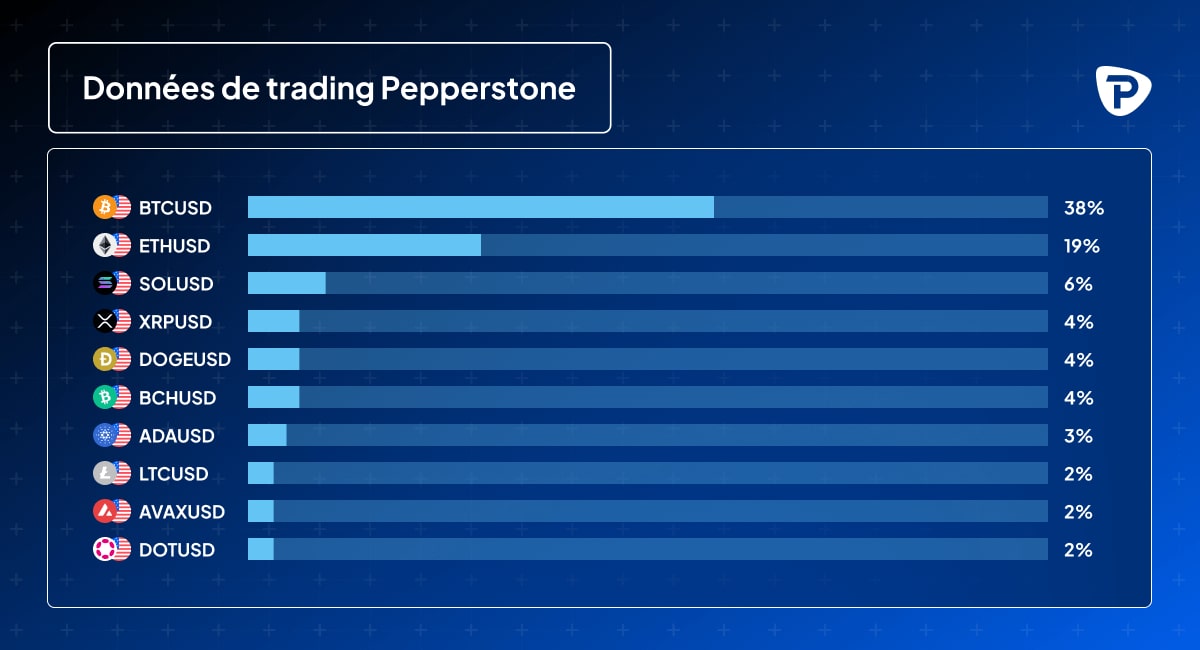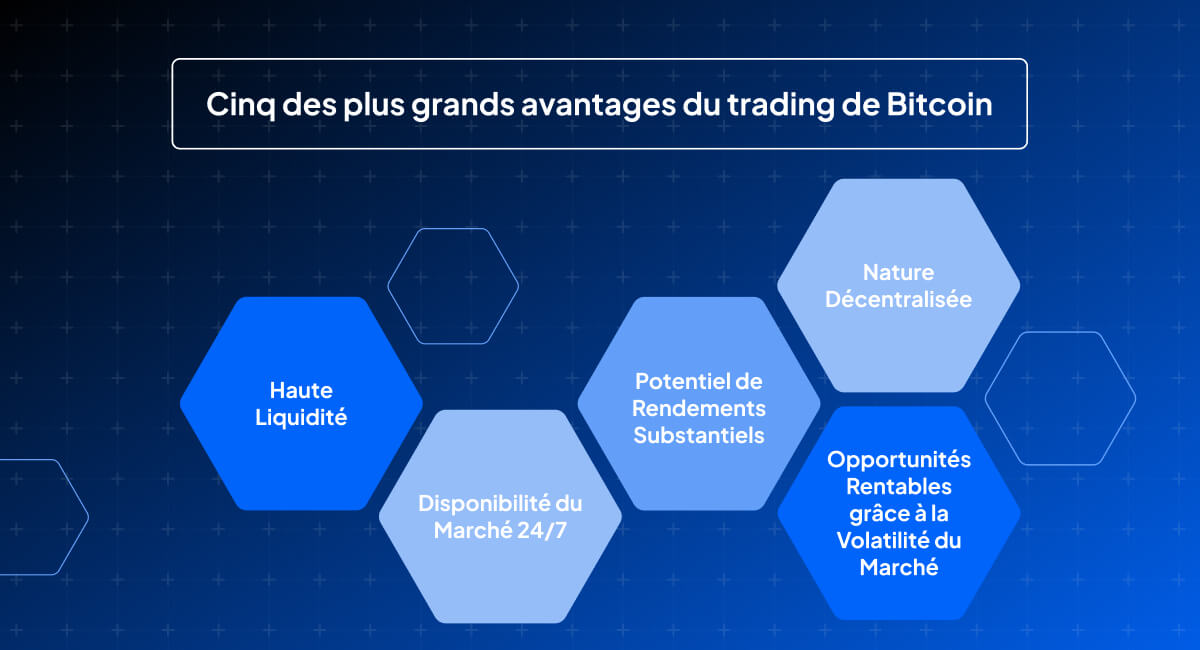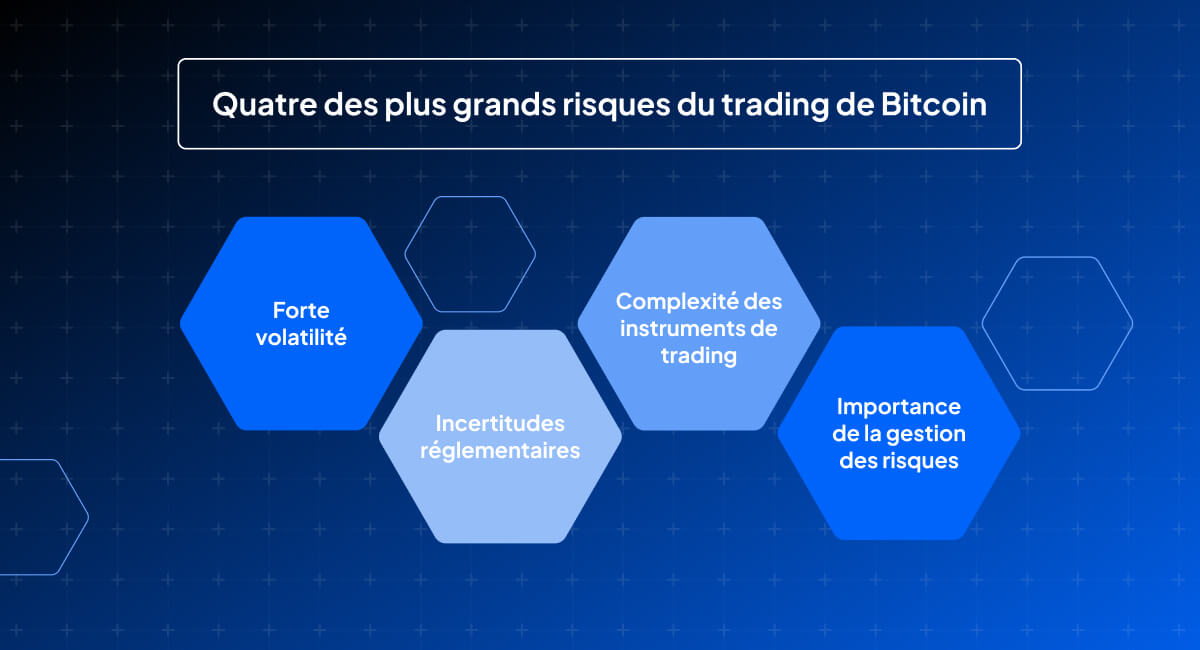Comment trader le Bitcoin
Le trading de Bitcoin a révolutionné le paysage traditionnel de l'investissement. En tant que principale cryptomonnaie, le Bitcoin reste l'actif numérique le plus échangé et discuté. Mais comment fonctionne le trading de Bitcoin, et quelles stratégies devez-vous adopter ?

Qu'est-ce que le trading de Bitcoin ?
Le trading de Bitcoin consiste simplement à acheter ou vendre la cryptomonnaie dans le but de réaliser un profit. Contrairement aux canaux d'investissement plus traditionnels, le trading de Bitcoin peut se faire via des échanges de cryptomonnaies ou via des dérivés financiers comme les contrats sur différence (CFD).
En raison de la nature décentralisée du Bitcoin, il n'est contrôlé par aucun gouvernement ni institution financière. Cela crée une expérience de trading unique, en particulier si vous êtes nouveau dans le domaine des cryptos.
Les traders peuvent profiter des fluctuations de prix du Bitcoin, influencées par des facteurs allant de la demande du marché aux conditions économiques mondiales. Compte tenu de la volatilité inhérente du Bitcoin, il existe de nombreuses opportunités pour les traders de réaliser des profits, ou de subir des pertes, en raison des variations de prix à court terme.
Comment fonctionne le trading de Bitcoin ?

Le trading de Bitcoin implique de spéculer sur les mouvements de prix de la cryptomonnaie. Cela peut se faire en prenant une position longue (achat) si une augmentation du prix est anticipée, ou une position courte (vente) si une baisse est attendue.
Le trading de Bitcoin peut se faire via des échanges de cryptomonnaies, où des Bitcoins réels sont achetés et vendus, ou via des courtiers proposant des contrats sur différence (CFD). Les CFD permettent aux traders de spéculer sur les mouvements futurs du marché sans posséder l'actif sous-jacent, ce qui peut aider à réduire le risque global.
Les traders peuvent utiliser des outils comme l'effet de levier et la marge, qui ont le potentiel d'augmenter les profits, mais aussi d'accroître les risques. Une bonne compréhension de l'analyse du marché, qu'il s'agisse de l'analyse technique ou fondamentale, est essentielle pour réussir dans le trading.
Pourquoi le Bitcoin est-il la cryptomonnaie la plus populaire ?

La popularité du Bitcoin découle de son statut de première cryptomonnaie.
Au-delà de son rôle pionnier, le Bitcoin est très liquide et largement accepté comme un actif numérique pour les paiements. Il bénéficie d'une forte reconnaissance de marque et dispose d'une grande communauté active soutenant son développement et son utilisation.
Le Bitcoin a une offre limitée à 21 millions de pièces, créant une rareté qui peut stimuler la demande. Son utilisation répandue comme réserve de valeur et moyen d'échange renforce encore sa position de leader sur le marché des cryptomonnaies. De plus, l'intérêt institutionnel important et l'adoption par des entreprises majeures ont contribué à son éminence.
Quels sont les facteurs qui influencent le prix du Bitcoin ?
Le prix du Bitcoin peut être influencé par divers facteurs, notamment :

Se tenir informé des dernières nouvelles du marché est essentiel pour rester bien informé sur ces facteurs, ainsi que sur d'autres, qui peuvent impacter le prix du Bitcoin.
Stratégies Bitcoin
Les traders de Bitcoin utilisent diverses stratégies adaptées à différents styles de trading et conditions du marché. Il est important de bien rechercher et comprendre chaque stratégie avant de les appliquer :
- Le day trading:
Le day trading consiste à acheter et vendre du Bitcoin au sein d'une même journée de trading afin de capitaliser sur les mouvements de prix à court terme. Les traders expérimentés utilisent l'analyse technique pour identifier des points d'entrée et de sortie et se basent souvent sur des indicateurs de marché et des schémas graphiques pour prendre des décisions rapides. Sachez que le day trading nécessite une surveillance constante du marché et peut être très chronophage. - Le swing trading
Le swing trading se concentre sur la capture de gains issus des fluctuations de prix sur plusieurs jours ou semaines. Les traders conservent des positions plus longtemps qu'une journée, mais moins longtemps que les investisseurs à long terme, en utilisant les tendances et les schémas de marché pour guider leurs décisions. Le swing trading offre un équilibre entre la fréquence des trades et les gains potentiels. - Le scalping
Les scalpers de Bitcoin cherchent à réaliser de petits bénéfices à partir de légers changements de prix, souvent en détenant des positions pendant seulement quelques minutes. Le scalping nécessite une discipline rigoureuse et une prise de décision rapide. Les scalpers peuvent effectuer de nombreuses transactions tout au long de la journée, avec pour objectif d'accumuler des profits de manière incrémentale. Une compréhension approfondie du marché et des compétences d'exécution rapide sont essentielles pour améliorer la performance, bien que le succès ne soit pas garanti. - HODL
HODL est un terme populaire dans la communauté Bitcoin pour désigner la conservation du Bitcoin sur une longue période, quelle que soit la volatilité du marché, dans la conviction que sa valeur à long terme augmentera. Cette stratégie repose sur la croyance fondamentale en la croissance future de Bitcoin et son potentiel en tant que réserve de valeur. Les HODLers ignorent souvent les fluctuations de prix à court terme au profit de gains à long terme. - Arbitrage
L'arbitrage consiste à acheter du Bitcoin sur une plateforme d'échange à un prix inférieur et à le revendre sur une autre plateforme à un prix supérieur, en profitant de la différence de prix. Cette stratégie nécessite des actions rapides et une connaissance des prix et des structures de frais des différentes plateformes à un moment donné. Les opportunités d'arbitrage peuvent être de courte durée et sont très sensibles au facteur temps. - Le trading de tendance
Le trading de tendance capitalise sur le momentum des mouvements de prix du Bitcoin. Les traders de tendance identifient la direction de la tendance et prennent des positions en conséquence, qu'il s'agisse de positions longues ou courtes. Cette stratégie repose sur l'hypothèse que les tendances actuelles continueront, permettant aux traders de profiter de la tendance jusqu'à ce qu'elle montre des signes de renversement. - Le trading de rupture
Le trading de rupture consiste à entrer sur le marché au début d'une tendance lorsque le prix franchit un niveau de support ou de résistance défini, avec une poursuite du mouvement dans cette direction attendue. Des niveaux clés sur un graphique sont identifiés et des transactions sont effectuées lorsque ces niveaux sont franchis, dans le but de capter la partie initiale d'une nouvelle tendance. - La réversion à la moyenne
La réversion à la moyenne est une stratégie basée sur l'hypothèse que le prix du Bitcoin reviendra à sa moyenne au fil du temps. Cette approche consiste à acheter lorsque les prix sont bas et à vendre lorsque les prix sont élevés, dans l'attente que les écarts par rapport à la moyenne soient temporaires. Elle repose sur le concept statistique selon lequel les prix reviennent à leur moyenne historique.. - Analyse fondamentale
L'analyse fondamentale consiste à déterminer la valeur intrinsèque du Bitcoin en examinant des facteurs tels que la technologie, le taux d'adoption et les conditions du marché. Cette analyse prend en compte les facteurs sous-jacents qui influencent la valeur du Bitcoin, notamment l'activité du réseau, les développements réglementaires et les indicateurs macroéconomiques, pour prendre des décisions de trading éclairées. - Analyse technique
L'analyse technique utilise des données historiques de prix et des schémas graphiques pour prédire les mouvements de prix futurs. Les traders utilisent des indicateurs tels que les moyennes mobiles, l'indice de force relative (RSI) et les niveaux de retracement de Fibonacci pour analyser les tendances du marché et identifier les opportunités de trading potentielles. Cette approche repose sur la conviction que les mouvements de prix historiques peuvent fournir des indications sur le comportement futur.
Devriez-vous couvrir vos positions en Bitcoin ?
La couverture du Bitcoin consiste à prendre des positions compensatoires pour réduire le risque de mouvements de prix défavorables. Bien que la couverture puisse protéger contre des pertes importantes, elle peut également limiter les gains potentiels. Cette stratégie est souvent utilisée pour gérer le risque sur des marchés volatils, réduisant ainsi l'exposition aux fluctuations de prix défavorables. Une solide compréhension des instruments dérivés et une planification minutieuse sont essentielles pour une couverture efficace du Bitcoin.
Avantages du trading de Bitcoin

- Haute Liquidité: Le Bitcoin peut être acheté ou vendu rapidement, ce qui en fait une option attrayante pour les traders cherchant à entrer ou sortir de positions facilement.
- Disponibilité du Marché 24/7: Le marché du Bitcoin est ouvert 24 heures sur 24, 7 jours sur 7, permettant ainsi de trader à tout moment, quelle que soit la zone horaire.
- Potentiel de Rendements Substantiels: Les fluctuations importantes des prix sur le marché des cryptomonnaies offrent des opportunités de rendements élevés.
- Opportunités Profitables grâce à la Volatilité du Marché: La volatilité du marché des cryptomonnaies peut générer de nombreuses opportunités de trading profitables.
- Nature Décentralisée: La décentralisation du Bitcoin offre une certaine indépendance par rapport aux systèmes financiers traditionnels, ce qui peut être attrayant pour les traders cherchant à diversifier.
Quels sont les risques du trading de Bitcoin ?

- Forte Volatilité: Les prix du Bitcoin peuvent fluctuer de manière spectaculaire, entraînant des gains ou des pertes importants. Cette volatilité constitue un risque majeur pour les traders.
- Incertitudes Réglementaires: L'absence de réglementation cohérente dans certains marchés peut exposer les traders à la fraude ou à la manipulation du marché. Les changements réglementaires peuvent également avoir un impact imprévisible sur le marché.
- Complexité des Instruments de Trading: Pour ceux qui débutent, des instruments comme les CFD (Contrats sur Différence) peuvent être complexes. Utiliser l'effet de levier sans expérience ou compréhension adéquate peut considérablement augmenter les risques.
- Importance de la Gestion des Risques: Il est crucial d'être préparé aux changements rapides du marché. Avoir des stratégies de gestion des risques solides est essentiel avant de commencer à trader du Bitcoin.
Qu'est-ce qu'un CFD sur Bitcoin ?
Un CFD sur Bitcoin (contrat pour différence) est un produit dérivé financier qui permet aux traders de spéculer sur les mouvements de prix du Bitcoin sans posséder l'actif réel. En négociant des CFD avec des courtiers comme Pepperstone, vous pouvez profiter à la fois des marchés haussiers et baissiers.
Les CFD offrent également un effet de levier, permettant aux traders de contrôler des positions plus importantes avec un montant de capital réduit. Cependant, il est important de connaître les risques impliqués, car l'effet de levier peut amplifier à la fois les gains et les pertes.
En résumé, trader des CFD sur Bitcoin peut être un moyen flexible et efficace d'explorer le marché volatil du Bitcoin.
Découvrez-en plus sur le trading de Bitcoin et de cryptomonnaies avec Pepperstone dès aujourd'hui.
FAQ sur les cryptomonnaies
Qu'est-ce que le Bitcoin ?
Le Bitcoin est une monnaie numérique décentralisée qui fonctionne sur un réseau peer-to-peer. Les utilisateurs peuvent envoyer et recevoir des paiements sans avoir besoin d'une autorité centrale. Il a été créé en 2009 par une personne ou un groupe de personnes sous le pseudonyme de Satoshi Nakamoto.
Pourquoi trader le Bitcoin ?
De nombreux traders estiment que le Bitcoin est une entreprise rentable en raison de sa forte volatilité. C'est aussi un moyen de se diversifier par rapport aux actifs financiers plus traditionnels et il peut être échangé 24h/24 et 7j/7.
Quelle sera la valeur d’un Bitcoin en 2030 ?
La valeur future du Bitcoin est hautement spéculative et dépend de facteurs tels que son adoption, les développements réglementaires et bien sûr la demande du marché. Les prédictions varient considérablement, certains experts prévoyant des augmentations substantielles tandis que d'autres prédisent une baisse.
Qu'est-ce que le minage de Bitcoin ?
Le minage de Bitcoin est le processus de validation et d'ajout de nouvelles transactions à la blockchain. Les mineurs utilisent des ordinateurs puissants pour résoudre des problèmes mathématiques complexes, ce qui leur permet de gagner des Bitcoins en récompense. Ce processus sécurise également le réseau et maintient l'intégrité des transactions.
Que sont les paires de trading Bitcoin ?
Les paires de trading Bitcoin sont des combinaisons de Bitcoin et d'autres cryptomonnaies (ou monnaies fiduciaires). Par exemple, BTC/USD est la paire de trading du Bitcoin et du dollar américain. Les traders utilisent les paires de trading pour spéculer sur la valeur relative du Bitcoin par rapport à d'autres devises.
Comment suivre les prix du Bitcoin ?
Vous pouvez suivre facilement les prix du Bitcoin en créant un compte Pepperstone et en utilisant la plateforme en ligne ou l'application Pepperstone Trading, qui fournit des données de prix en temps réel, des graphiques et des outils d'analyse du marché. Il est crucial de se tenir informé des mouvements du marché et des actualités pour réussir vos trades.
Qu'est-ce que le halving du Bitcoin ?
Le halving du Bitcoin est un événement qui se produit environ tous les quatre ans. Il réduit de moitié la récompense par bloc pour les mineurs. Ce mécanisme contrôle l'offre de Bitcoin et peut influencer son prix en créant une rareté accrue. Le dernier halving a eu lieu en avril 2024, quatre ans après le précédent (et troisième) halving en mai 2020. Le prochain halving du Bitcoin devrait se produire autour du 20 avril 2028.
Le matériel fourni ici n'a pas été préparé conformément aux exigences légales visant à promouvoir l'indépendance de la recherche en investissement et est donc considéré comme une communication à des fins de marketing. Bien qu'il ne soit soumis à aucune interdiction de traiter avant la diffusion de recherches en investissement, nous ne chercherons pas à en tirer profit avant de le fournir à nos clients.
Pepperstone ne garantit pas que le matériel fourni ici est exact, à jour ou complet, et ne doit donc pas être considéré comme tel. L'information, qu'elle provienne d'une tierce partie ou non, ne doit pas être considérée comme une recommandation, une offre d'achat ou de vente, ni comme une sollicitation d'offre d'achat ou de vente de tout titre, produit financier ou instrument, ni comme une participation à une stratégie de trading particulière. Elle ne prend pas en compte la situation financière ou les objectifs d'investissement des lecteurs. Nous conseillons aux lecteurs de ce contenu de chercher leurs propres conseils. Sans l'approbation de Pepperstone, la reproduction ou la redistribution de cette information n'est pas autorisée.